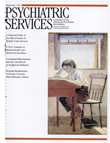Command hallucinations and the prediction of dangerousness
Abstract
OBJECTIVES: Recent studies have supported the belief that command hallucinations can induce dangerous behavior. This study tried to replicate previous findings that compliance with the command was associated with delusions related to hallucinations and the ability to identify the hallucinated voice. This study also assessed the association between compliance and the dangerousness of the command, chronicity of illness, a diagnosis of schizophrenia, and past compliance with hallucinated commands. METHODS: The most recent command hallucination reported by 93 psychiatric inpatients was rated for level of dangerousness and level of compliance with the command. RESULTS: Subjects who experienced less dangerous commands or who could identify the hallucinated voice reported higher levels of compliance, although reported compliance with more dangerous commands was not uncommon. Commands experienced in the hospital were less dangerous than those experienced elsewhere and tended to be specific to the hospital environment. Subjects were less likely to comply with commands experienced in the hospital. CONCLUSIONS: Based on their self-reports, psychiatric patients who experience command hallucinations are at risk for dangerous behavior. Ability to identify the hallucinated voice is a fairly reliable predictor of reported compliance. Level of dangerousness resulting from compliance with command hallucinations may be a function of the patient's environment.
Access content
To read the fulltext, please use one of the options below to sign in or purchase access.- Personal login
- Institutional Login
- Sign in via OpenAthens
- Register for access
-
Please login/register if you wish to pair your device and check access availability.
Not a subscriber?
PsychiatryOnline subscription options offer access to the DSM-5 library, books, journals, CME, and patient resources. This all-in-one virtual library provides psychiatrists and mental health professionals with key resources for diagnosis, treatment, research, and professional development.
Need more help? PsychiatryOnline Customer Service may be reached by emailing [email protected] or by calling 800-368-5777 (in the U.S.) or 703-907-7322 (outside the U.S.).



